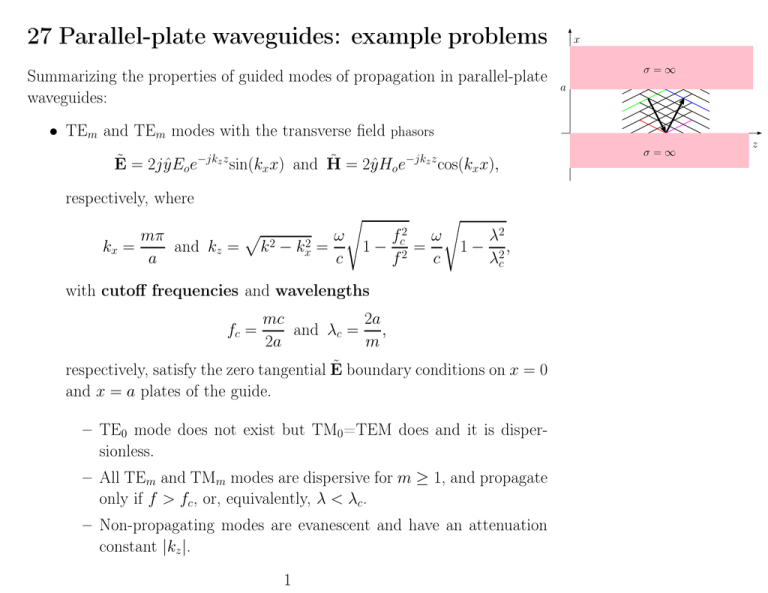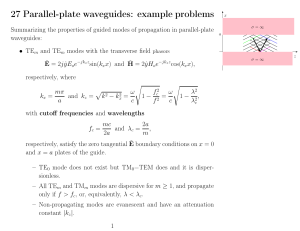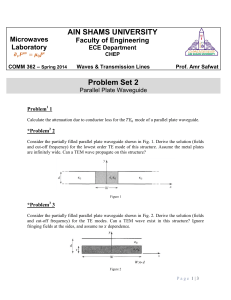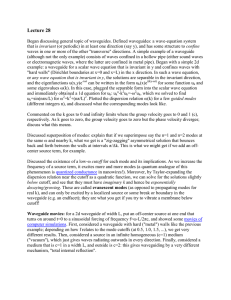27 Parallel-plate waveguides: example problems
advertisement

27 Parallel-plate waveguides: example problems Summarizing the properties of guided modes of propagation in parallel-plate waveguides: • TEm and TEm modes with the transverse field phasors Ẽ = 2j ŷEoe −jkz z sin(kx x) and H̃ = 2ŷHo e respectively, where ! mπ ω kx = and kz = k 2 − kx2 = a c " 1− −jkz z fc2 f2 cos(kx x), ω = c " λ2 1 − 2, λc with cutoff frequencies and wavelengths fc = mc 2a and λc = , 2a m respectively, satisfy the zero tangential Ẽ boundary conditions on x = 0 and x = a plates of the guide. – TE0 mode does not exist but TM0=TEM does and it is dispersionless. – All TEm and TMm modes are dispersive for m ≥ 1, and propagate only if f > fc , or, equivalently, λ < λc. – Non-propagating modes are evanescent and have an attenuation constant |kz |. 1 x a σ=∞ σ=∞ z • Also TEm and TEm mode fields have guide impedances " Ey ηo Ex fc2 =# and ηT M = = ηo 1 − 2 ηT E = fc2 −Hx H f y 1− f2 relating the transverse field components of the guided modes. All the results summarized above are for air-filled waveguides, but they can be readily modified, by replacing c and ηo with c/n and η, respectively, in the case of dielectric-filled waveguides. Example 1: Consider a dielectric-filled parallel-plate waveguide with a = 2 cm. The permeability of the dielectric filling is µo and its refractive index is n = 1.5. 1. Which TEm and TMm modes can propagate a 12 GHz signal in the waveguide? 2. What would be the associated cutoff wavelengths in each case? 3. What would be the associated group velocities in each case? — here assume a modulated 12 GHz carrier with a narrow modulation bandwidth. Solution: Unguided propagation velocity for the dielectric filling the waveguide is m 3 × 108 m/s c = 2 × 108 . v= = n 1.5 s Using v in place of c in the cutoff frequency formula for TEm and TMm modes we find m × 2 × 1010 cm/s mv = = m5 × 109 Hz = 5m GHz. fc = 2a 2 × 2 cm 2 1. f = 12 GHz exceeds the cutoff frequencies of TEm and TMm for m = 1 and 2, but not 3. Therefore, the propagating (i.e., non-evanescent) modes at f = 12 GHz are TM0 , TE1 , TM1 , TE2 , and TM2 . 2. Cuttof-wavelength are given by the equation 2a m λc = and do not depend on the dielectric filling. They are, with a = 2 cm, λc = 4 cm for TE1=TM1 and λc = 2 cm for TE2 =TM2. The cutoff wavelength is ∞ for TEM mode (which does not have a cutoff condition). 3. Group velocities are given by the equation vg = v " fc2 1− 2 f where v = c/n. For the non-dispersive TEM mode with fc = 0 the group velocity is vg = 2 × 108 m/s. For TE1 and TM1 modes $ 52 vg = v 1 − 2 = 1.82 × 108 m/s. 12 For TE2 and TM2 modes vg = v $ 1− 102 = 1.11 × 108 m/s. 2 12 3 Example 2: Consider an air-filled parallel-plate waveguide with a = 3 cm. Calculate the guide wavelength λg or the attenuation rate in dB/cm of the TE1 mode in the guide — whichever appropriate — if the operating wavelength of the mode is (a) λ = 3 cm, and (b) λ = 12 cm. Solution: The cutoff wavelength of TE1 mode in the guide is λc = 2a 2 × 3 cm = = 6 cm. m 1 (a) For λ = 3 cm, λ < λc , and, therefore, the TE1 mode is propagating. The propagation constant, that is kz , is " " 2 λ 2π λ2 kz = k 1 − 2 = 1− 2 λc λ λc and the guide wavelength is λg = 2π λ =# kz 1− λ2 λ2c √ 3 cm 3 cm 3 cm =# =# = # = 2 3 cm. 2 3 1 − 14 1 − 362 4 (b) For λ = 12 cm, λ > λc , and, therefore, the TE1 mode is evanescent. The attenuation constant is |kz |, where " " $ 2 λ 2π λ2 2π 122 π√ π 1− 2 = 1− 2 = −3 = ±j √ rad/cm. kz = k 1 − 2 = λc λ λc 12 6 6 2 3 Therefore, the attenuation rate is π 20 log10 e|kz | = |kz |20 log10 e = √ × 8.686 ≈ 7.88 dB/cm. 2 3 4 Example 3: A parallel-plate waveguide with a = 3 cm is air filled for z < 0 but it is filled with a dielectric for z > 0 which has µ = µo and a refractive index n = 1.5. If a TE1 mode wave field with λ = 3 cm is incident from the air-filled region on the interface at z = 0, what fraction of the time-averaged incident power will be transmitted into the z > 0 region of the guide? Solution: The cutoff wavelength of TE1 mode in the guide is λc = 2a 2 × 3 cm = = 6 cm. m 1 For λ = 3 cm, the intrinsic impedance of the TE1 mode fields is therefore ηT E1 = # ηo 1− λ2 λ2c in the air filled section. 120π 120π 240π =# = # = √ Ω 2 3 3 1 − 362 4 Within the dielectric region the operation wavelength is λ2 = λ/n = 3/1.5 = 2 cm, and, therefore the intrinsic impedance is ηo /n 120π/1.5 80π 240π = # = # = √ Ω. ηT E2 = # 2 2 8 8 1 − λλ22 1 − 262 9 c Thus, using a transmission line analogy, the reflection coefficient at the interface is √ √ √1 − √1 3 − 8 ηT E2 − ηT E1 3 √ √ = 18 = = −0.24, Γ= √ + √1 ηT E2 + ηT E1 3 + 8 8 3 which is the transverse electric field amplitude of the reflected wave in the air filled region divided by the incident electric field amplitude. 5 Consequently, the fraction of the incident time-averaged power reflected back from the interface is the reflectance |Γ|2 ≈ 0.058, and 1 − |Γ|2 ≈ 0.942 represents the transmittance, the fraction of the incident time-averaged power transmitted into the dielectric filled region. 6




